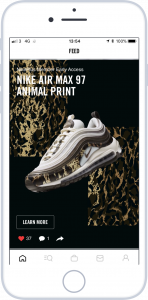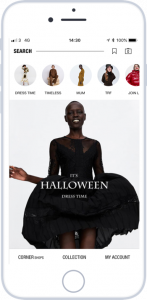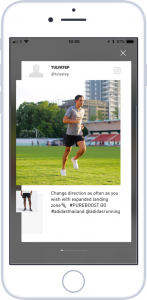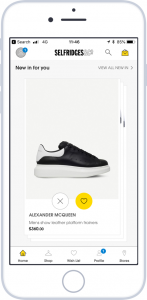The influencer: Using the app home screen to tell your brand’s story.

The social force of Instagram – with 1 billion monthly users and 300 million people using Instagram Stories per day – has changed everything we do; from how we socialize, interact and perceive to how we are influenced to eat, exercise and shop.
Consumers are no longer looking to brands to influence their purchasing behaviours, instead, they are looking to their fellow consumers, social groups and their favourite personalities. This is why the art of telling a story is becoming increasingly more powerful; and your app can help.
Nike, Zara and Selfridges are among some of the brands who are using their apps – in particular their app’s homescreen – to create great, authentic and genuine experiences that provoke the same approval and influence achieved through social media channels such as Instagram.
The Homescreen Landscape
Traditionally viewed as the “connector” for the app, the homescreen listed product categories with the purpose of taking the customer on various journeys. In an attempt to provoke engagement, the homescreen generally includes a list of static advertisement; it usually not personalised, nor relevant to the customer’s situation or circumstance.
With over 92% of customers viewing the homescreen; exactly how are brands utilising this space to tell their story and inspire their customers to purchase?
The social feed
Creating a social feel with functionality such as Nike’s “Feed” has become a major homescreen trend. The focus is placed on content relevant to the brand – such as large, attractive imagery and animation – as opposed to price point, offers and driving the customer to different areas of the app.
Brands such as Nike are utilising well learned social behaviours such as “Like”, “Comment” and “Share” to provoke engagement by creating a sense of community and connection where customers can share their thoughts and opinions. Creating a social feed experience also creates a sense of social approval by allowing customers to view what conten and products are liked by others.
The social feed is ultimately creating an opportunity to share inspiring and engaging content chosen by and relevant to the brand; at a time when a customer is actively seeking to interact.
Stories

A feature that envolved out of the social platform, Snapchat, and has since moved into other maintream channels such as Facebook and Instagram has started to make its’ debut in retail apps.
Offering a new way to view content – that moves away from the traditional scroll-down functionality – Stories can be placed at the top of the home screen to entice customers to interact and view content in a language they have become accustomed to.
Zara is a great example of how Stories have been integrated well into the retail app experience. Effectively, they are using Stories as a way to encourage interactions with products. They are telling the user a story of what are the relevant and trending products without sacrifiicing the homescreen space.
Other retail apps that have integrated Stories have used the feature to relay content from social channels whilst taking the opportunity to link it to the relevant products. Utilising Stories in this way poses the threat of disengagement if the brand does not update with the same frequency as they do in other channels.
Gamification
Video content, animation and GIFs are becoming common place in retail apps.

Adidas is an excellent case study regarding how strategic animation and video content can bring an app to life and capture the customer’s attention. Combined with the social element, apps are becoming increasingly gamified whereby customers are encouraged to interact directly with content rather than solely concentrate on shopping; encouraging and re-engagement.
The Personalised Approach
58% of customers are willing to share their data under the right circumstances and if there are clear benefits. That’s an opportunity to deliver personalised and relevant brand experiences to over half of app customers.
Brands are becoming more forthcoming in asking for information when a customer is using their app. Nowadays, it is not uncommon to be asked for information such as your Name, Date of Birth and Interests. Nike and ASOS are two brands who have used this information effectively in their apps. For example, Nike connect the customer’s story to the brand by personalizing the app with their photo and showing homescreen content relevant to their interests.
Instagram on the Homescreen

Over the last two years, the retail industry has experimented with how Instagram can be integrated into apps.
In one of their latest app releases, Adidas has found an effective way to combine
Instagram content with shopping functionality. The app homescreen consists of a horizontal scrollable module – with impressive animation – that showcases Instagram users with Adidas products. The product is included within the app’s Instagram view directing the user to the relevant product page.
Although Adidas still has some fine tuning to do – with every Instagram user’s name directing you to the Instagram’s founder’s page – it is an effective way to integrate engaging social content into the app experience and encouraging customers to interact with the brand socially.
Newness
Placing relevant – the key being relevance – new in products on the homescreen creates an instant connection between the brand and the customer. As soon as the customer launches the app, the brand is showing that they understand their interests thereby encouraging them to explore further.

Across the retail app industry, there has been a lot of experimentation regarding how customers interact with and browse new in products. Selfridges & Co., has made new in browsing interactive and engaging with “Swipe to Like” where the products suggested are based on their user’s selected preferences and interests.
The “Swipe to Like” feature is another example of gamification within a retail app with the same functional approach as apps like Tinder where the customer can swipe to the right to add a favoured product to their wishlist.
Whilst it can be viewed as a gimmick and the longevity of such features is yet to be determined, features such as “Swipe to Like” are a great example of creating a fun retail environment that helps to convey a brand’s personality.
Trending
Creating popularity, urgency and purchase appeal is an element that is being done extremely well throughout retail apps.
Trending Now products displayed on the homescreen give customers a compelling reason to act now. Highlighting trending products also helps to build upon social shopping where a customer can view what others are purchasing; creating effective brand communities that help to build relationships and create long term loyalty.
If you wish to discuss your app’s homescreen strategy or find out more about the features discussed please get in touch.
 The social force of Instagram – with 1 billion monthly users and 300 million people using Instagram Stories per day – has changed everything we do; from how we socialize, interact and perceive to how we are influenced to eat, exercise and shop.
Consumers are no longer looking to brands to influence their purchasing behaviours, instead, they are looking to their fellow consumers, social groups and their favourite personalities. This is why the art of telling a story is becoming increasingly more powerful; and your app can help.
Nike, Zara and Selfridges are among some of the brands who are using their apps – in particular their app’s homescreen – to create great, authentic and genuine experiences that provoke the same approval and influence achieved through social media channels such as Instagram.
The social force of Instagram – with 1 billion monthly users and 300 million people using Instagram Stories per day – has changed everything we do; from how we socialize, interact and perceive to how we are influenced to eat, exercise and shop.
Consumers are no longer looking to brands to influence their purchasing behaviours, instead, they are looking to their fellow consumers, social groups and their favourite personalities. This is why the art of telling a story is becoming increasingly more powerful; and your app can help.
Nike, Zara and Selfridges are among some of the brands who are using their apps – in particular their app’s homescreen – to create great, authentic and genuine experiences that provoke the same approval and influence achieved through social media channels such as Instagram.
 A feature that envolved out of the social platform, Snapchat, and has since moved into other maintream channels such as Facebook and Instagram has started to make its’ debut in retail apps.
Offering a new way to view content – that moves away from the traditional scroll-down functionality – Stories can be placed at the top of the home screen to entice customers to interact and view content in a language they have become accustomed to.
Zara is a great example of how Stories have been integrated well into the retail app experience. Effectively, they are using Stories as a way to encourage interactions with products. They are telling the user a story of what are the relevant and trending products without sacrifiicing the homescreen space.
Other retail apps that have integrated Stories have used the feature to relay content from social channels whilst taking the opportunity to link it to the relevant products. Utilising Stories in this way poses the threat of disengagement if the brand does not update with the same frequency as they do in other channels.
A feature that envolved out of the social platform, Snapchat, and has since moved into other maintream channels such as Facebook and Instagram has started to make its’ debut in retail apps.
Offering a new way to view content – that moves away from the traditional scroll-down functionality – Stories can be placed at the top of the home screen to entice customers to interact and view content in a language they have become accustomed to.
Zara is a great example of how Stories have been integrated well into the retail app experience. Effectively, they are using Stories as a way to encourage interactions with products. They are telling the user a story of what are the relevant and trending products without sacrifiicing the homescreen space.
Other retail apps that have integrated Stories have used the feature to relay content from social channels whilst taking the opportunity to link it to the relevant products. Utilising Stories in this way poses the threat of disengagement if the brand does not update with the same frequency as they do in other channels.
 Adidas is an excellent case study regarding how strategic animation and video content can bring an app to life and capture the customer’s attention. Combined with the social element, apps are becoming increasingly gamified whereby customers are encouraged to interact directly with content rather than solely concentrate on shopping; encouraging and re-engagement.
Adidas is an excellent case study regarding how strategic animation and video content can bring an app to life and capture the customer’s attention. Combined with the social element, apps are becoming increasingly gamified whereby customers are encouraged to interact directly with content rather than solely concentrate on shopping; encouraging and re-engagement.
 Over the last two years, the retail industry has experimented with how Instagram can be integrated into apps.
In one of their latest app releases, Adidas has found an effective way to combine
Instagram content with shopping functionality. The app homescreen consists of a horizontal scrollable module – with impressive animation – that showcases Instagram users with Adidas products. The product is included within the app’s Instagram view directing the user to the relevant product page.
Although Adidas still has some fine tuning to do – with every Instagram user’s name directing you to the Instagram’s founder’s page – it is an effective way to integrate engaging social content into the app experience and encouraging customers to interact with the brand socially.
Over the last two years, the retail industry has experimented with how Instagram can be integrated into apps.
In one of their latest app releases, Adidas has found an effective way to combine
Instagram content with shopping functionality. The app homescreen consists of a horizontal scrollable module – with impressive animation – that showcases Instagram users with Adidas products. The product is included within the app’s Instagram view directing the user to the relevant product page.
Although Adidas still has some fine tuning to do – with every Instagram user’s name directing you to the Instagram’s founder’s page – it is an effective way to integrate engaging social content into the app experience and encouraging customers to interact with the brand socially.
 Across the retail app industry, there has been a lot of experimentation regarding how customers interact with and browse new in products. Selfridges & Co., has made new in browsing interactive and engaging with “Swipe to Like” where the products suggested are based on their user’s selected preferences and interests.
The “Swipe to Like” feature is another example of gamification within a retail app with the same functional approach as apps like Tinder where the customer can swipe to the right to add a favoured product to their wishlist.
Whilst it can be viewed as a gimmick and the longevity of such features is yet to be determined, features such as “Swipe to Like” are a great example of creating a fun retail environment that helps to convey a brand’s personality.
Across the retail app industry, there has been a lot of experimentation regarding how customers interact with and browse new in products. Selfridges & Co., has made new in browsing interactive and engaging with “Swipe to Like” where the products suggested are based on their user’s selected preferences and interests.
The “Swipe to Like” feature is another example of gamification within a retail app with the same functional approach as apps like Tinder where the customer can swipe to the right to add a favoured product to their wishlist.
Whilst it can be viewed as a gimmick and the longevity of such features is yet to be determined, features such as “Swipe to Like” are a great example of creating a fun retail environment that helps to convey a brand’s personality.
